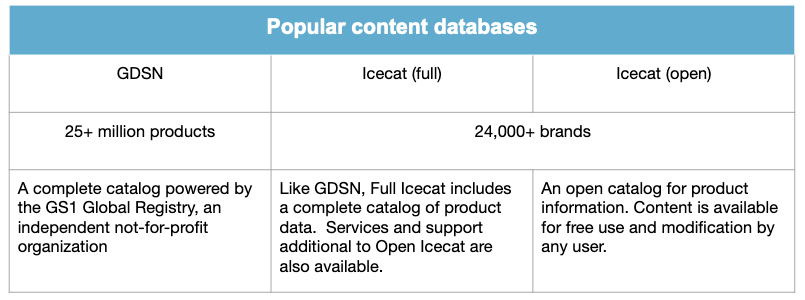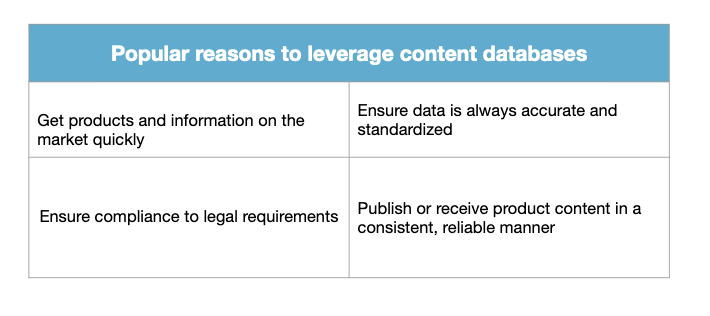Content databases like the Global Data Synchronization Network (GDSN), Icecat, Syndigo and Kwikee make it easy for companies to locate the key (and often complex) details required to list and sell products both online and offline. They are a reliable tool that lets companies publish and receive product information all in one place. In short, if you’re a brand or retailer: you should consider adding one to your channel strategy.
What is GDSN?
The Global Data Synchronization Network is one of the largest content databases available, including the GS1 Global Registry who defined the GS1 standards used in many industries. It is one of the most popular content databases.
Though useful for many scenarios, these databases were first created to support the logistics industry—they weren’t built for digital commerce or the future. They’re great for shuffling logistics data but they are not used for consumer-facing content or expanding channel strategies. They don’t include product information catered to specific channels and audiences nor do they include all of the attributes required by different channels.
Thus, while these databases will continue to add value, businesses need something designed for modern commerce and ecommerce if they want to grow and stay relevant. They need reliable, accessible data that is tailored to customer-facing channels. Before we get to customizing data, let’s look more closely at the content databases available and why you may want to include them in your channel strategy.

The ecosystem
What are GDSN and other product content databases?
Content databases, including GDSN, Icecat, and Syndigo, act as repositories for the basic product information often needed by brands and retailers. This may include attributes like color and brand name as well as logistics-relevant details like handling instruction codes or exact size and weight measurements. All of this data is standardized and available for use by those granted access.
Key content database use cases:
- publishing product content for retailers and marketplaces
- receiving product content from suppliers
Who uses these databases and why?
From Kroger to Amazon, most major companies work with some kind of content database. The databases are particularly relevant in relation to marketplaces and highly technical products, where specific and accurate details are required but not always readily available.

How it works
With GDSN, the brand owner starts by uploading GTINs to their data pool. Trading partners subscribe to this GTIN in order to get that data and any updated data published by the brand owner. This data pool is the partner’s single point of entry into the GDSN. They do not have access to data outside of the specifically approved pools.
Standardized vs. tailored product content
Data pulled from content databases is perfect for populating required attributes like GTIN or product weight; however, shopper-ready titles, descriptions, and images will not be included. In fact, should a company create ads and listings based solely on information from a content database, they would end up with the exact same information and listing as hundreds of other businesses. This means there’s no possibility to stand out among competitors or optimize for popular keywords and SEO. Everyone involved would use the same information across hundreds of sites and customer-facing channels.
This is also why businesses need to “tailor” product content. Data obtained from GDSN and other databases are a solid foundation. For example, it may help a shopper looking for a given serial number. However, a customer casually looking for a purse will need a title that speaks to them, including the product name, brand, and key details like color—all of this needs to be tailored and properly formatted.
Moreover databases often lack channel-specific attributes, including both required attributes like Google product category or tax as well as sales-focused attributes like custom labels, variants, and additional image links. Hence many retailers and marketplaces require additional data or simply build their own portal. Walmart is a prime example, as the popular retailer has its own complete database.
GDSN and content databases are part of a healthy channel strategy—not the whole strategy
First and foremost, it should be clear to brand manufacturers and retailers of all kinds that content databases offer a huge value. They absolutely should be considered in most channel strategies. However, it should also be clear that the content database is only one piece of the puzzle.
- *Brand manufacturers* should be prepared to reach directly to the consumer and also syndicate product content to additional popular channels. With new platforms like Google Manufacturer Center, brands have a number of new opportunities to take advantage of.
- *Retailers* will still need to provide unique customer experiences and that includes tailoring content and providing additional information, images, or even video. These companies should be prepared to take that raw data and completely optimize it for the target channels.
Regardless of whether you’re syndicating to or receiving content from databases, you will need additional tools and strategies. Software like Productsup, for example, makes it easy to import, prepare, and syndicate data automatically.
Supporting solutions for stronger content database strategies
There are agencies out there who will tailor and syndicate product content for you. Of course, this solution means handing over a lot of power to an external group. Productsup makes it easy to do this job in-house. It requires no coding and no special knowledge. Simply use drag-and-drop rules to cleanse and standardize data before exporting to a content database. Or, schedule a time to pull data from that database into your feed.
But that’s just the beginning. Those same, easy-to-use rules can be used to automatically turn raw data into channel-specific customer-ready feeds. That means, you can quickly connect your raw data sources and end channels with one simple solution.

![[WP Import] The role of GDSN in modern commerce and ecommerce (and why you need more)](http://images.ctfassets.net/q17uls4wkkdz/1rElMovOy553oeIRRn5Dhz/845381d8d2c6938f596a6c790ce7eed9/content-databases-gdsn.jpg?w=1200&h=675&fit=FILL)